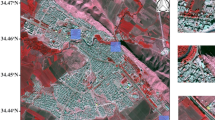Abstract
High-resolution remote sensing images not only improve the processing quality of image information, but also become more effective, accurate, and clear in specific practical applications such as feature recognition, classification, and object detection. The construction and development of urban wetland parks have become a new trend in urban construction both domestically and internationally. This article first builds a map symbol library and formulates data processing rules based on ArcGIS software, and designs a high-resolution GIS image flowchart. Adding jump connections to the convolutional neural network can effectively improve the performance of the overall network model. By utilizing the advantages of jump connections in convolutional neural networks, a more dense connection network is proposed through multiple uses and improvements in convolutional neural networks. Finally, design a wetland park environmental data monitoring platform and analyze and process the data based on the wetland park environmental monitoring indicators. The research results indicate that the algorithm proposed in this paper retrieves most high-frequency information without adding too much noise. The edge sharpening effect of traditional algorithms is relatively poor, and the model proposed in this paper outperforms other super-resolution reconstruction algorithms, improving the performance of the model in terms of visual effects in remote sensing image reconstruction. The typical application scenario of wetland protection and management based on temporal and spatial data constructed in this article has achieved large-scale, fast, and accurate analysis of wetland resource conditions, and verified the application support capabilities of cloud computing platforms.










Similar content being viewed by others
Data availability
Data will be made available on request.
References
Adam E, Mutanga O, Rugege D (2010) Multispectral and hyperspectral remote sensing for identification and mapping of wetland vegetation: a review. Wetlands Ecol Manag 18:281–296
Aufa MN, Rusmansyah R, Hasbie M, Jaidie A, Yunita A (2021) The effect of using e-module model problem based learning (PBL) based on wetland environment on critical thinking skills and environmental care attitudes. J Penelit Pendidik IPA 7(3):401–407
Cazzato D, Cimarelli C, Sanchez-Lopez JL, Voos H, Leo M (2020) A survey of computer vision methods for 2d object detection from unmanned aerial vehicles. J Imaging 6(8):78
Dong Z, Wang M, Wang Y, Zhu Y, Zhang Z (2019) Object detection in high resolution remote sensing imagery based on convolutional neural networks with suitable object scale features. IEEE Trans Geosci Remote Sens 58(3):2104–2114
Gao F, You J, Wang J, Sun J, Yang E, Zhou H (2017) A novel target detection method for SAR images based on shadow proposal and saliency analysis. Neurocomputing 267:220–231
Gupta AK, Seal A, Prasad M, Khanna P (2020) Salient object detection techniques in computer vision—a survey. Entropy 22(10):1174
Jay S, Jones C, Slinn P, Wood C (2007) Environmental impact assessment: retrospect and prospect. Environ Impact Assess Rev 27(4):287–300
Mahyuni M, Syahrin MN (2021) Sister city cooperation model in wetland environmental governance: case study in Banjarmasin, south of Kalimantan. Int J Politic Public Policy Environ Issues 1(02):115–125
Mhalla A, Chateau T, Gazzah S, Amara NEB (2018) An embedded computer-vision system for multi-object detection in traffic surveillance. IEEE Trans Intell Transp Syst 20(11):4006–4018
Prasad DK, Prasath CK, Rajan D, Rachmawati L, Rajabaly E, Quek C (2016) Challenges in video based object detection in maritime scenario using computer vision. arXiv preprint arXiv:1608.01079.
Sholahuddin ARIF, Fitriyana R, Sya’ban MF, Sadiqin IK (2021) Students™ caring attitudes to wetland environment: a case of environmental education in Banjar district Indonesia. J Pendidik IPA Indones 10(1):149–158
Song S, Albert C, Prominski M (2020) Exploring integrated design guidelines for urban wetland parks in China. Urban for Urban Green 53:126712
Toro J, Requena I, Zamorano M (2010) Environmental impact assessment in Colombia: critical analysis and proposals for improvement. Environ Impact Assess Rev 30(4):247–261
Xiao D, Shan F, Li Z, Le BT, Liu X, Li X (2019) A target detection model based on improved tiny-yolov3 under the environment of mining truck. IEEE Access 7:123757–123764
Zeng Y, Zhang P, Zhang J, Lin Z, Lu H (2019) Towards high-resolution salient object detection. In: Proceedings of the IEEE/CVF international conference on computer vision, pp 7234–7243
Zhang Y, Yuan Y, Feng Y, Lu X (2019) Hierarchical and robust convolutional neural network for very high-resolution remote sensing object detection. IEEE Trans Geosci Remote Sens 57(8):5535–5548
Zhang C, Chen Y, Yang X, Gao S, Li F, Kong A, Sun L (2020) Improved remote sensing image classification based on multi-scale feature fusion. Remote Sens 12(2):213
Zhao Q, Bai J, Huang L, Gu B, Lu Q, Gao Z (2016) A review of methodologies and success indicators for coastal wetland restoration. Journal 2(60):442–452
Zhou W, Lin X, Lei J, Yu L, Hwang JN (2021) MFFENet: multiscale feature fusion and enhancement network for RGB–thermal urban road scene parsing. IEEE Trans Multimed 24:2526–2538
Funding
The authors have not disclosed any funding.
Author information
Authors and Affiliations
Corresponding author
Ethics declarations
Conflict of interest
The authors declare that they have no known competing financial interests or personal relationships that could have appeared to influence the work reported in this paper.
Ethical approval
This article does not contain any studies with human participants performed by any of the authors.
Additional information
Publisher's Note
Springer Nature remains neutral with regard to jurisdictional claims in published maps and institutional affiliations.
Rights and permissions
Springer Nature or its licensor (e.g. a society or other partner) holds exclusive rights to this article under a publishing agreement with the author(s) or other rightsholder(s); author self-archiving of the accepted manuscript version of this article is solely governed by the terms of such publishing agreement and applicable law.
About this article
Cite this article
Zheng, H. Wetland park environmental data monitoring based on GIS high resolution images and machine learning. Soft Comput (2023). https://doi.org/10.1007/s00500-023-08898-z
Accepted:
Published:
DOI: https://doi.org/10.1007/s00500-023-08898-z




